Reviews
James Bond III
USA, 1990
Credits
Review by Adam Balz
Posted on 18 October 2012
Source Troma DVD
Categories 31 Days of Horror IX
When Bram Stoker’s Dracula was published in 1897 it introduced the world to what would become one of literature’s - and cinema’s - most iconic monsters. The monster drew immediate comparisons to historical figures like Elizabeth Bathory and Vlad the Impaler, but Stoker’s inspirations for the archetypical vampire seem to have been more contemporaneous: immigrants from continental Europe and epidemics that followed in their wake.
Stoker, however insensitively, was adapting social conditions in turn-of-the-century Britain for use in his novel, investing in his many characters, especially Dracula himself, a complex and touchy metaphorical utility. This utility, over the last few decades, has made its way into Dracula’s cinematic depictions, used extensively by writers and directors of all creeds and colors, including - to much variety and entertainment - African-Americans. On Thursdays throughout the month, we will examine the role of vampires as metaphors, as well as how those metaphors have shifted and changed according to evolving American social mores.
During the 1984 presidential election, Ronald Reagan’s campaign released the now legendary “Morning in America” ad, in which the incumbent president’s first term is depicted as one of peace and prosperity, of blue-collar optimism. Reagan, of course, won reelection by an unthinkably wide margin—a victory often attributed, in part, to the ad. But the irony is that, during Reagan’s sunrise presidency, the African-American vampires of Crain and Gunn and Kelljan disappeared from sight, having taken refuge in their coffins while Reagan’s home-spun confidence shined bright.
When Reagan’s less popular, less charismatic second-in-command took the Oath of Office in January, 1989, the vampires - and corresponding metaphors - reemerged, only now they were different. Still mindful of racial identity - Bush’s campaign had, after all, created the notorious ad linking Democratic challenger Michael Dukakis with convicted black rapist and murderer Willie Horton - the African-American vampires of post-Reagan America had new concerns: socioeconomics, homosexuality, and AIDS.
During Reagan’s eight-year presidency, as white America rose to “morning again” on the horizon, African-Americans witnessed the gap between themselves and the rest of the country widen. The Civil Rights bills of the last two decades may have worked to make African-Americans equal under the laws of voting and proportional representation, but it did not to stem the social and cultural inequality that had risen up to take its place. By the end of his second term, Reagan had become remarkably distant from the African-American community, an uncharacteristically unusual legacy for a modern American president:
Had Reagan met black Americans halfway on a few issues or paid more attention to the black community, most blacks would not have been left with only one choice in every election from Goldwater to Bush. Instead, they got a president who appointed almost no blacks to high office and who did not recognize his only black cabinet appointee in one of the rare moments that they actually met… [B]lacks, in the face of Reagan’s relentless insensitivity to their history, achievements, and leaders, were left to be demonized or at best ignored by one party and often taken for granted by the other.1
There was also the sudden appearance of AIDS which, according to Cheryl Cole, acquired “the status of the extraordinary in popular consciousness”1. Reagan’s seeming disregard towards the plight of gay men and women made the epidemic grow all the more massive, leading to 100,000 “AIDS-related deaths” by Winter of 19912, with 75-percent of AIDS sufferers the year before identified as “homosexual or bisexual men”3. In only “his second major speech on AIDS”4, delivered less than 15 months before leaving office, Reagan said, “I’ve asked the Department of Health and Human Services to determine as soon as possible the extent to which the AIDS virus has penetrated our society and to predict its future dimensions. I’ve also asked HHS to add the AIDS virus to the list of contagious diseases for which immigrants and aliens seeking permanent residence in the United States can be denied entry.” By this point in time, the death count was more than 25,0003.
When Def by Temptation was released in 1990, the film’s revolutionary focus - on the unspoken taboos of homosexuality, addiction, and AIDS in the African-American community - could be attributed to only one man: James Bond III5. In addition to starring in the film, Bond wrote, produced, and directed Def by Temptation, the story of a black seductress named Temptation who preys on men in bars, luring them back to her apartment for sex and, eventually, a bite in the neck.
But Temptation is far from the tradition of vampires established by Blacula and Dr. Pride, or even Dracula himself; instead, she seems derived more from Gunn’s Ganja, as both women can walk in daylight (albeit in sunglasses for Temptation) and are visible in mirrors. Similarly, because Def by Temptation and its nearest predecessor, Kelljan’s Scream, Blacula, Scream, were released seventeen years apart, Bond’s film is far from what could be considered a traditional horror film at the time.
Def by Temptation is the story of Joel, a seminary student who visits his brother K in New York against the wishes of his grandmother, a religious woman who has watched over both boys since the death of their parents in a car accident. The trip, according to Joel, is his attempt to make sure the life of a preacher is what he truly wants.
K is the opposite of Joel. A successful actor, he lives in a swanky New York apartment where he’s surrounded by ostentatious luxuries, including a kitschy, life-sized dummy of Ronald Reagan. With over-accentuated, almost caricature-like features - wrinkled face, squinty eyes, jagged cheeks and chin - the dummy is seated in K’s living room behind a TV-set that also doubles as a makeshift Oval Office desk. The prop has only slight metaphorical powers at first, presiding over K’s embodiment of success - an apartment with the latest technology, a full wardrobe, flashy knickknacks - and watching from the corner as the brothers talk; near the end of the film, as Temptation tries to seduce Joel into becoming both her next lover and victim, the dummy is brought to life, leaning forward in a fit of possession as the television screen on his desk swallows up Joel and, only seconds later, regurgitates a puddle of flesh and blood on the living-room floor. Reagan, both the dummy and the real-life person, are treated as puppets of AIDS—complicit in the devouring and destruction of a successful black man.
Unlike prominent national figures, who chose to demonize homosexuals by blaming them almost entirely for the AIDS epidemic—Cynthia Cole opens her article with quotes by two men, Gory Servaas and Jerry Falwell, who portray AIDS as both treasonous (“It’s patriotic to have the test and be negative”) and sinful (“AIDS is God’s judgment of a society that does not live by His rules”), respectively3—Bond uses vampirism as a metaphor for AIDS as it pertains to promiscuous men and women, regardless of orientation. The fact that Bond chose to name the antagonist Temptation is telling, especially during flashbacks to Joel’s childhood, in which his father stands at the pulpit of his church sermonizing against small-t temptation in all its forms. He is condemning all those who would engage in any form of self-satisfaction with little regard for others, or even the health of their own soul, whether they are men or women, white or black, gay or straight.
In fact, Bond does not depict AIDS as a punishment for promiscuity, or as a deserved outcome, but rather as a disease crippling the African-American community; he doesn’t lay blame, pointing the finger at one group of people over the other as men like Servass and Falwell did, but uses the film to remind his viewers that AIDS is an epidemic affecting everyone. The balance between both - AIDS as punishment and as a problem in need of a solution - is delicate, as McKinnon notes when discussing how other academics write about the epidemic:
An obvious problem for exponents of AIDS-as-divine-retribution is that nonmembers of the punished group also fall ill. Examples of such “undeserving” sufferers are children and hemophiliacs who are known not to be drug abusers or homosexuals. Hancock and Carim… fall into a trap when they ask, reasonably, “What have they done, these ill-starred infants, to deserve such a bleak future?” Their question summons up the likelihood that there are others facing a bleak future who have done something by reason of which they deserve that future.3
In fact, Bond’s depictions of homosexuality, though infrequent, are mostly sympathetic. All of Temptation’s victims are adamantly straight - a bartender, an unfaithful husband - with the exception of one man, who Temptation identifies as gay (“With a woman, it’s much better”); while she has to use little energy in seducing her other victims - they often come to her - she actively seeks out this man, even slipping him her address and phone number rather than trying to escort him home. When the scene cuts to them in her apartment, Temptation is visibly dominant over him in bed, penetrating him sexually with something unseen before violently killing him. This man appeared earlier in the film as a lone figure sitting at the bar. When another man approaches and asks if he’d like a drink, Temptation’s future victim responds
First Man
Tell me something—with all the men in this bar, am I really that obvious?Second Man
Well, excuse me, honey! I go to more sophisticated gay bars than this and you look [snaps fingers] somewhat familiar to me.First Man
Really, no offense. I’m just here for some conversation, I’m really not looking for anything tonight…
The second man eventually walks away, and the first remains alone until his fateful rendezvous with Temptation, which begins interestingly enough with him being sexually dominant but her frustrated, angry; when she rolls alongside him on the bed and he asks if he did anything wrong, she responds, “Yes.” If Bond levels any condemnation at gay men in his film, it’s not because of their gay-bar lifestyle or the stigma surrounding them—he criticizes them, as personified by this one lone man, for not accepting who they truly are, for trying to pass themselves off as straight. If this man hadn’t come to Temptation’s door willingly, he would never have become a vampire—that is, in the metaphor of this film, he would never have contracted AIDS.
Bond’s film also carries a strong message about faith—an unusual choice when you consider how his predecessors portrayed the cure for vampirism as voodoo rather than Western religions; even Ganja and Hess, which has the most ambiguous depiction of religion of all the vampire films examined herein, leaves the possibility for Christianity to be viewed as the cause of vampirism. Def by Temptation, however, contains little ambiguity on the topic of religion—it is the overriding good of Bond’s film, more than brotherhood or even community. The further Joel moves away from his faith, the more he falls into Temptation’s trap, and in increasingly dramatic and straightforward dreams we see Joel’s dead father returning to fight against Temptation for his son’s soul. When Joel finally kills Temptation, he does so not with a stake or rope of garlic but rather by shining the light of a cross on her and rebuking her.
Bond illustrates the dominance of religion over all else by slowly stripping away everything Joel could possibly rely on to fight Temptation. K is sucked into the television, while his grandmother’s attempts late in the film to stop Temptation are futile at best; Temptation pins the old woman against the walls of her apartment, choking her. And Joel’s best hope, a government agent named Doug who specializes in the supernatural and teams up with K, is quickly dispatched by Temptation and a cab-full of her fellow victims. Even Joel’s father, dead for years, is shown in flashback - or dream, we’re never sure - in a car with his wife, speeding towards the shadowy figure of Temptation as she stands motionless in the middle of the road; he recognizes her, and his goal is to run her down, to remove her for good, but the car veers off the road and crashes.
In their search for answers, K and Doug visit Madame Sonja, a seer whose religious identity seems to be split between traditional voodoo practices - she begins their meeting by sprinkling particles over her table - and Christian ideology, as personified by the large cross behind her. She tells both men, “There is only one way that ‘it’ can be completely destroyed, and that is for man’s total being and spirit to remain focused upon, and to be completely submissive to the utmost reality, which of course is God.” At a later mention of Temptation’s name, Sonja becomes possessed by her, and through her Temptation warns both K and Doug that any attempt to fight her will end in their deaths, which is ultimately what happens.
Madame Sonja’s words about the “utmost reality” are especially important when considering the role of religion, and especially the “Black church,” in the fight against AIDS. In her article, Cole writes that
Although racial differences in regard to HIV infection are acknowledged, the higher rate of infection among African Americans is narrated through a logic of addiction… that simultaneously structures and makes visible the failed authority of the black community through the figure of the Black church. As the most prominent surrogate for the black community, the Black church is positioned as having neglected its authoritative role, allowing homophobia to interfere with its education of the black communit6.
Joel’s grandmother refers to his battle with Temptation as a “test of faith,” as there are scenes that make blatant visual allusions to Christian theology, including Temptation playing with snakes (temptation as it pertains to Genesis) and K and Doug’s attempt at weakening Temptation by having a bartender mix holy water with an alcoholic drink, which is then served to her. The concoction works for only a minute, during which both men attempt to stake her with little success; almost immediately afterwards, both men are killed.
The DVD of Def by Temptation, released by legendary Troma Studios, contains an open letter from Bond to Troma founder Lloyd Kaufmann, as well as his staff, that precedes the actual film. In it, Bond writes “DEF BY TEMPTATION is an historical endeavor in that it is the first contemporary all-black horror film of its kind. Both cast and crew worked very hard to insure that we were creating a monumental event.” Because the entire vampire culture began with an epidemic in 1897 England, it seems only appropriate that the topic of AIDS should be covered, at least as it pertains to the African-American community, by a film comprised entirely of black actors and crew-members. Two years after Bond’s film, when Francis Ford Coppola released Dracula to theaters, the outbreak of venereal diseases that had originally inspired Bram Stoker’s novel were replaced by AIDS as the foundation for the narrative’s larger metaphor.
- Mayer, Jeremy D. “Reagan and Race: Prophet of Color Blindness, Baiter of the Backlash.” Deconstructing Reagan: Conservative Mythology and America’s Fortieth President. Armonk, New York: M.E. Sharpe. 70—89. ↩
- Harper, Philip Brian. “Eloquence and Epitaph: Black Nationalism and the Homophobic Response [to] the Death of Max Robinson.” Writing AIDS. Ed. T. Murphy and S. Poirier. Rpt. in The Greatest Taboo: Homosexuality in Black Communities. Ed. Delroy Constantine Simms. New York: Alyson Books, 2001. 396—414. ↩
- MacKinnon, Kenneth. The Politics of Popular Representation: Reagan, Thatcher, AIDS, and the Movies. Toronto: Associated University Press, 1992. ↩
- PBS. “President Reagan’s amFAR Speech.” May 12, 2008. ↩
- Though Def by Temptation can be seen as the first African-American vampire film to acknowledge AIDS, Ridley Scott’s 1983 film The Hunger is, according to Nicole Nixon, “considerably less remarkable for its depiction of an early 1980s vampirism than… for its stunning resemblance to an extended AIDS allegory” (117). ↩
- Cole, Cheryl. “Containing AIDS: Magic Johnson and Post-Reagan America.” Queer Theory/Sociology. Ed. S. Seidman. Cambridge, MA: Blackwell, 1996. Rpt. in The Greatest Taboo: Homosexuality in Black Communities. Ed. Delroy Constantine Simms. New York: Alyson Books, 2001. 415-440. ↩
More 31 Days of Horror IX
-

The Addiction
1995 -

Psycho III
1986 -

Wake in Fright
1971 -

Blacula
1972 -
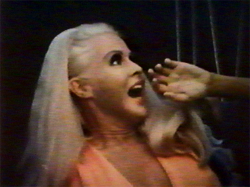
Big Foot
1970 -

Trollhunter
2010 -
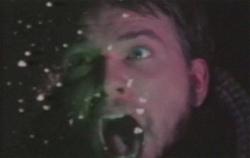
Invasion from Inner Earth
1974 -

In the Company of Men
1997 -

Happy Birthday to Me
1981 -

I Drink Your Blood
1970 -

The Legend of Boggy Creek
1972 -

Maximum Overdrive
1986 -

The Giant Spider Invasion
1975 -

Ganja & Hess
1973 -
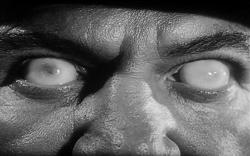
Not of This Earth
1957 -

Let’s Scare Jessica to Death
1971 -

Next of Kin
1982 -

Def by Temptation
1990 -

Shriek of the Mutilated
1974 -

The Manster
1959 -
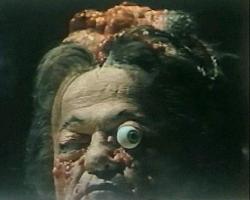
The Alpha Incident
1978 -

The Bride
1985 -

Planet of the Vampires
1965 -

The Hole
2009 -

Vampire in Brooklyn
1995 -

Sasquatch: the Legend of Bigfoot
1977 -

Mad Love
1935 -
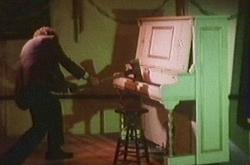
The Demons of Ludlow
1983 -

Habit
1997 -

Elephant
1989 -

The Blair Witch Project
1999
We don’t do comments anymore, but you may contact us here or find us on Twitter or Facebook.



